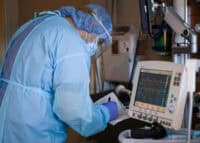Baxter International Inc. (NYSE: BAX) is set to break up into two companies on or around July 1, 2015. While there have been many assumptions built into the outlook of analysts and the company itself, there is a mixed view on what the pre-split valuation should be. If Merrill Lynch’s Bob Hopkins and team are correct, Baxter is worth a lot more than its current share price would indicate.
On a pre-split basis, Merrill Lynch has a Buy rating and a $78.00 price objective. This compares to a $67.50 current share price. Also, the consensus analyst price target is almost $74. The official street-high price target is up at $82.00, and Baxter shares have traded in a range of $65.94 to $77.31 in the past 52 weeks.
So, what is it that Merrill Lynch sees? For starters, the firm has set many targets on the new Baxter. The analyst team gave a view on revenue growth and margins, total debt, net interest, other expenses, tax rates, liquidity and earnings per share. Below are some of the comments from the firm on each metric named above:
- We model organic revenue growth of 4% in 2016 and 2017. For operating margins, we model 10.2% and 11.5% for 2016 and 2017, ahead of guidance.
- We model total gross debt at the time of the spin of $6 billion ($10 billion less $4 billion from the Baxalta special dividend). By the end of 2017 we model gross debt of $4.6 billion although Baxter has the capacity to get to $4.6 billion much earlier.
- We model net interest expense of $147 million and $120 million for 2016 and 2017. We model a 3.2% cost of debt on $4.6 billion in debt for 2017 offset by a 2% return on $1.3 billion in cash on the balance sheet.
- Hedging gains have helped this line item recently but we do not model that going forward. We model $10-$12mm in royalty expense in 16/17.
- We model tax in-line with guidance of 20.5% and 21% in 2016 and 2017.
- There will be $1 billion in cash on the new Baxter’s balance sheet at the time of the spin and roughly $4 billion in assets from Baxter’s equity stake in Baxalta. Baxter will also generate $400 million of free cash flow in 2016 and $520 million in 2017.
- Baxter will need $1.5 billion for additional debt pay down to reduce debt to the $4.5 billion area needed to meet Baxter’s leverage target of 2.5x gross debt/EBITDA. Baxter will need $500 million to $1 billion for pension. Baxter’s dividend will use $250 to $300 million of cash annually. Baxter will have close to $3 billion in tax efficient liquidity for deals or buybacks between now and 2017.
ALSO READ: 5 Top Potential Biotech Buyout Candidates
Merrill Lynch went on to say:
The mid 2015 spin is a catalyst for the stock. Post-spin, we believe the medical products (New Baxter) has the most opportunity given margin expansion. Additionally, the market is pricing in significant share loss that we do not believe takes into account potential failures from competitors and/or Baxalta’s pipeline/business development opportunities. Any opportunities of competitor data failing would also serve as a positive catalyst.
Using a share count of 548 million and 528 million, after using $600 million for buybacks in 2017, the firm gets to a 2016 EPS of $1.20 and 2017 EPS of $1.65.
Based on earnings, Merrill Lynch believes that the new Baxter will trade in the $30 to $33 range after the spin-off, with close to $3 billion of liquidity.
If investors want to decide how to view the new Baxter and Baxalta on their own, the company’s full investor conferences showed their strategy into and after the business separations.
The Average American Has No Idea How Much Money You Can Make Today (Sponsor)
The last few years made people forget how much banks and CD’s can pay. Meanwhile, interest rates have spiked and many can afford to pay you much more, but most are keeping yields low and hoping you won’t notice.
But there is good news. To win qualified customers, some accounts are paying almost 10x the national average! That’s an incredible way to keep your money safe and earn more at the same time. Our top pick for high yield savings accounts includes other benefits as well. You can earn up to 3.80% with a Checking & Savings Account today Sign up and get up to $300 with direct deposit. No account fees. FDIC Insured.
Click here to see how much more you could be earning on your savings today. It takes just a few minutes to open an account to make your money work for you.
Our top pick for high yield savings accounts includes other benefits as well. You can earn up to 4.00% with a Checking & Savings Account from Sofi. Sign up and get up to $300 with direct deposit. No account fees. FDIC Insured.
Thank you for reading! Have some feedback for us?
Contact the 24/7 Wall St. editorial team.



